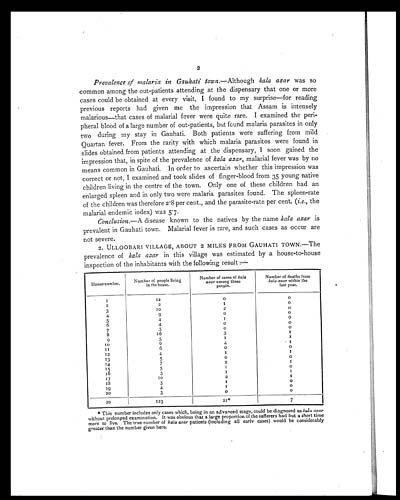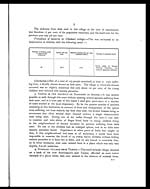Medicine - Institutions > Army health reports and medical documents > Scientific memoirs by officers of the Medical and Sanitary Departments of the Government of India > Number 19 - On kala azar, malaria and malarial cachexia > On kala azar, malaria and malarial cachexia
(10) Page 2
Download files
Individual page:
Thumbnail gallery: Grid view | List view

2
Prevalence of malaria in Gauhati town.—Although kala azar was so
common among the out-patients attending at the dispensary that one or more
cases could be obtained at every visit, I found to my surprise—for reading
previous reports had given me the impression that Assam is intensely
malarious—that cases of malarial fever were quite rare. I examined the peri-
pheral blood of a large number of out-patients, but found malaria parasites in only
two during my stay in Gauhati. Both patients were suffering from mild
Quartan fever. From the rarity with which malaria parasites were found in
slides obtained from patients attending at the dispensary, 1 soon gained the
impression that, in spite of the prevalence of kala azar, malarial fever was by no
means common in Gauhati. In order to ascertain whether this impression was
correct or not, I examined and took slides of finger-blood from 35 young native
children living in the centre of the town. Only one of these children had an
enlarged spleen and in only two were malaria parasites found. The spleen-rate
of the children was therefore 2.8 per cent., and the parasite-rate per cent. (i.e., the
malarial endemic index) was 5.7.
Conclusion.—A disease known to the natives by the name kala azar is
prevalent in Gauhati town. Malarial fever is rare, and such cases as occur are
not severe.
2. ULLOOBARI VILLAGE, ABOUT 2 MILES FROM GAUHATI TOWN.—The
prevalence of kala azar in this village was estimated by a house-to-house
inspection of the inhabitants with the following result:—
| House-number. | Number of people living in the house. |
Number of cases of kala azar among these people. |
Number of deaths from kala azar within the last year. |
| 1 | 12 | 0 | 0 |
| 2 | 2 | 1 | 0 |
| 3 | 10 | 2 | 0 |
| 4 | 9 | 0 | 0 |
| 5 | 4 | 1 | 0 |
| 6 | 4 | 0 | 0 |
| 7 | 3 | 0 | 0 |
| 8 | 16 | 3 | 1 |
| 9 | 5 | 1 | 1 |
| 10 | 0 | 4 | 1 |
| 11 | 6 | 0 | 0 |
| 12 | 4 | 1 | 1 |
| 13 | 5 | 0 | 0 |
| 14 | 7 | 2 | 1 |
| 15 | 5 | 1 | 0 |
| 16 | 3 | 1 | 1 |
| 17 | 10 | 2 | 1 |
| 13 | 5 | 1 | 0 |
| 19 | 4 | 1 | 0 |
| 20 | 3 | 0 | 0 |
| 20 | 123 | 21* | 7 |
*This number includes only cases which, being in an advanced stage, could be diagnosed as kala azar
without prolonged examination. It was obvious that a large proportion of the sufferers had but a short time
more to live. The true number of kala azar patients (including all early cases) would be considerably
greater than the number given here.
Set display mode to: Large image | Zoom image | Transcription
Images and transcriptions on this page, including medium image downloads, may be used under the Creative Commons Attribution 4.0 International Licence unless otherwise stated. ![]()
| Permanent URL | https://digital.nls.uk/75027503 |
|---|
| Shelfmark | IP/QB.10 |
|---|---|
| Additional NLS resources: | |



![[Page 1]](https://deriv.nls.uk/dcn4/7502/75027502.4.jpg)
